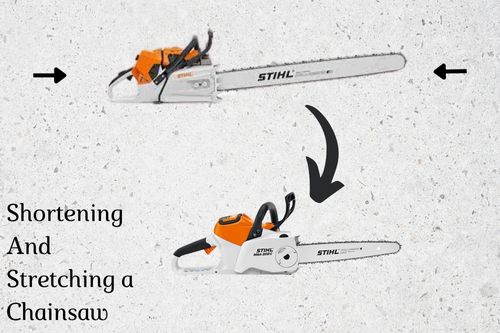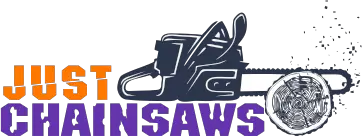A chainsaw is a crucial tool for arborists, tree surgeons, and passionate DIYers. However, even the best things have to come to an end—or at least their parts do. A few factors such as wood type (e.g., hardwood or softwood), manufacturer quality, and exposure to friction all add up to whether you should simply sharpen your current saw or replace it entirely.

If your chainsaw’s chain has worn out, you might be wondering if you should replace it or just get a new one. This is because when the chain becomes loose, it can often fall off of the sprocket or break while in use.

Shortened chains can also cause further damage and make them more likely to jump off or break while cutting through a tree, which could lead to a dangerous situation.
The two main reasons you might need to shorten your chainsaw are if (1) you bought a replacement that’s too long or (2) one of the chain links is damaged.
In either case, though, it’s essential that the new chain has an equal number of cutting teeth and drive sprockets as the old one. Otherwise, the chain will not run evenly.
If you want to shorten your chainsaw chain, you can either take it to a professional or do it yourself. However, if you choose the latter option, make sure that your saw has a master link. These types of links make shortening the chain much simpler and don’t require any special tools – all you need to do is use a pair of pliers to push the pin in or pull it out.
If your chainsaw is worn out, you don’t need to shorten it. You just need to change it. You can find replacement chains at most hardware stores, and they’re fairly straightforward to install yourself.
Is it safe to shorten a chainsaw chain?
Shortening a chainsaw that is already worn out can cause serious damage if done incorrectly–so it’s important to make sure that your saw is in good condition before trying to do it yourself.
They include:
Overheating – This is a very serious issue. Chainsaws emit large amounts of heat, and overheating can be a huge problem. If the chainsaw gets too hot, it could start smoking or even catch fire. This would be extremely dangerous for anyone operating the saw.
Operational Difficulties – If an operator is cutting an object and feels a rattling sensation, this is a sign that the chain is not installed properly and is likely to fall off or break. This can lead to serious injury if the operator is unaware of what is happening, so it’s important to make sure that your chainsaw chain is installed correctly.
Damage to the Chain – If a chain has been shortened incorrectly, it could cause damage to the individual links or even the entire chain. This could make the chainsaw dangerous to operate and lead to serious injury if it breaks while in use.
Ragged Cuts – When you use a dull chainsaw, it becomes significantly more difficult to make clean cuts. A lack of precision is inevitable, as you will have to apply quite a bit of pressure just to get the saw moving.
Serious Risk of Accidents – Accidents may occur as a result of careless chainsaw use. If you are not paying attention while operating a saw, or if your chain is loose or damaged, there is a high risk of accidents occurring. This could lead to serious injuries and even death in some cases.
If you plan on shortening a chainsaw, below are some precautions you should take:
Precautions to Take when Shortening a Chainsaw
Shortening a chainsaw is quite simple but before you begin, you should take some precautionary measures.
- Always use the right safety gear, such as goggles, ear protection, and a face mask.
- To avoid the chainsaw accidentally turning on, disconnect it from its power source by removing the battery, unplugging it from the socket, and removing its spark plug.
- Before starting, check the chain tension and alignment, making sure that all links line up evenly as you cut.
- Be very careful when handling the new chain and make sure to use proper tools like pliers or calipers to install it. Do not force any of the links into place and be especially careful with masterlinks, as they can be easily damaged or broken.
Shortening a Chainsaw with a Master Link
Most people recognize the masterlink on a chainsaw as being a different color, and it often has some type of locking mechanism.
To shorten this type of saw, you will need:
- A chain-breaking tool: This is used to break the link chain and push out new links.
- A replacement master link: This will replace the original masterlink.
- A swaging device: This is used to reconnect the chain.
Follow the steps below to shorten your chain.
- The masterlink is usually fairly easy to find as it looks different than the rest of the links. Find it, then pop it open using a chain breaking tool.
- To replace a link, first remove the broken one by disconnecting it from its current location. Then, take the new replacement link and connect it to the next available spot, which would be the vacated position of the removed link.
- Use the chain break tool to remove excess links until you have reached your desired length.
- Next, use the swaging device to reattach the links together with the new master link.
- To put the chain back on the saw, loosen the pressure from the tension screw and attach the chain around the blade.
- To check the tension, use the screw to tighten it and pull on the chain. If there is no sag, then it is at the right tension. If there is sag, start again until the proper tension is achieved.
Shortening a Chainsaw without a Master Link
Shortening a chainsaw with or without a masterlink is quite similar. The only difference is the use of a special rivet tool.
- Remove the rivets you don’t need from the chain using a rivet tool.
- Once you have reached your desired length, reattach the links.
- To reattach the chain, first loosen the tension screw. Next, thread the chain around the blade.
- To test the tension, tighten the tension screw and test it by pulling the chain away.
- If it does not sag, then the level of tension is where it should be. If there is any sagging, repeat the steps listed above until you reach the desired amount of tension.
Final Thoughts
In conclusion, several factors can result in a chainsaw being stretched out or shortened. Whether you are using a masterlink or regular rivets, it is always important to take proper safety precautions when working with any chainsaw.
Make sure to use the right gear and tools, check the tension and alignment of the chain before cutting, and be careful not to damage any of the links while installing new ones.
Use these tips to safely shorten your chainsaw and enjoy all the benefits of a perfectly-sized tool.
